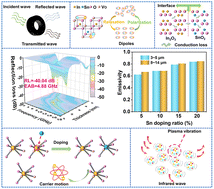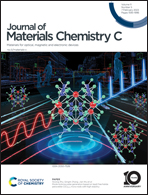Indium tin oxide as a dual-band compatible stealth material with low infrared emissivity and strong microwave absorption†
Abstract
With the explosive development of modern military detection technology, stealth compatibility for materials with both outstanding microwave absorption (MA) and low infrared emissivity is urgently needed. In this paper, indium tin oxide (ITO) nanoparticles with high-efficiency MA and infrared stealth properties were successfully prepared by a steerable method using metal chloride salts as indium and tin sources, and the influence of tin proportion on their structure and properties was discussed. The prepared ITO nanoparticles possessing abundant carriers and defects are beneficial to construct a suitable conductive network, and the polarization process is enhanced by the existence of homogeneous and heterogeneous interfaces, so that strong absorption is generated. Remarkably, the obtained ITO with a single dielectric loss type can realize an effective absorption bandwidth (EAB) of 4.88 GHz with a matching thickness of 2.8 mm. In addition, ITO-5 has the lowest infrared emissivity (0.62) in the range of 3–14 μm, while ITO-10 exhibits the best infrared/radar compatible stealth effect. The lowest reflection loss and the widest EAB for ITO-10 are respectively −20.07 dB and 3.83 GHz, while the infrared emissivity is 0.64. Therefore, ITO shows a broad application prospect in anti-detection, and provides an option for multispectral compatible stealth materials.



 Please wait while we load your content...
Please wait while we load your content...